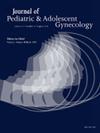35. 阴道纵隔切除技术估计的出血量和安全性
IF 1.7
4区 医学
Q3 OBSTETRICS & GYNECOLOGY
引用次数: 0
摘要
背景阴道纵向间隔(LVS)是一种先天性异常,在出现卫生棉条困难等症状的青少年中可以切除。目前有几种手术切除技术,包括烧灼或双极电刀切除。我们的研究目的是评估Bovie®烧灼术与LigaSure™血管密封装置切除在失血或术后并发症方面是否存在差异。我们假设两种手术技术的出血量和并发症都很低。方法回顾性研究2012年至2024年在儿科和青少年妇科护理的单一儿科三级医疗机构接受LVS切除术的所有患者。患者要么采用烧灼或血管密封装置切除;两种方法均对阴道粘膜进行覆盖。统计数据、临床特征、估计失血量和术后并发症从病历中提取。这项研究得到了机构审查委员会的批准。结果44例患者在研究期间接受了LVS切除术,平均年龄17岁。最常见的症状是棉条困难(52%),其次是痛经(39%)和性交困难(9%)。11%的人没有任何症状。大多数患者(84%)有两次服务;1个子宫颈7例(16%)。32例(73%)患者行烧灼术,11例(25%)行血管封闭术,1例(2%)两者均行。两种方法的平均失血量无显著差异(13 ml vs. 4 ml, p=.10)。术后并发症罕见。7例(16%)患者在术后平均12天就诊于急诊科。在这7名患者中,3名患者表现为阴道出血,1名患者表现为阴道分泌物,3名患者表现为与急诊科认为与手术无关的症状。1名患者因在急诊科前估计失血400毫升而进行了紧急翻修,在手术室中抽血100毫升,翻修时活动性失血10毫升。3例因出血就诊急诊科的患者中,2例行烧灼术,1例行血管封闭术。结论LVS手术时的总出血量较低,不同手术技术的出血量差异不显著,尽管血管密封有减少出血量的趋势,这可能随着样本量的增加而变得明显。两种方法的术后并发症也很少见,尽管2例患者(4%)出现了意想不到的问题——一例明显的手术间组织易碎性和另一例细菌性阴道病。外科医生可能会考虑使用几种技术来安全地进行LVS切除术。本文章由计算机程序翻译,如有差异,请以英文原文为准。
35. Estimated blood loss and safety by technique for longitudinal vaginal septum excision
Background
Longitudinal vaginal septum (LVS) is a congenital anomaly that may be excised in adolescents with symptoms such as tampon difficulty. Several techniques for surgical excision exist, including excision with cautery or a bipolar electrosurgical instrument. Our study objective was to evaluate if any difference in blood loss or postoperative complications existed between excision with Bovie® cautery versus with the LigaSure™ vessel sealing device. We hypothesized that blood loss and complications were low with both surgical techniques.
Methods
This was a retrospective study of all patients who underwent LVS excision at a single pediatric tertiary care institution under the care of the Pediatric and Adolescent Gynecology division from 2012 to 2024. Patients either underwent excision using cautery or a vessel sealing device; the vaginal mucosa was oversewn after either technique. Demographics, clinical characteristics, estimated blood loss, and postoperative complications were abstracted from the medical chart. This study was approved by the Institutional Review Board.
Results
44 patients underwent excision of LVS during the study time period, mean age 17 years. The most common presenting symptom was tampon difficulty (52%) followed by dysmenorrhea (39%), and dyspareunia (9%). Eleven percent had no symptoms reported. The majority of patients (84%) had 2 cervices; 7 (16%) had 1 cervix. Thirty-two patients (73%) underwent cautery, 11 (25%) underwent vessel sealing, and 1 (2%) both. Mean blood loss was not significantly different with both techniques (13 vs. 4 ml, p=.10). Postoperative complications were rare. 7 (16%) patients presented to the emergency department (ED), average 12 days post-surgery. Of these 7 patients, 3 presented for vaginal bleeding, 1 for vaginal discharge, 3 for symptoms deemed unrelated to surgery by the ED. One patient underwent emergent revision due to an estimated 400 ml blood loss prior in the ED, with 100 ml blood evacuated in the OR and 10 ml active blood loss with the revision. Of the 3 patients who presented to the ED for bleeding concerns, 2 underwent cautery, and 1 underwent vessel sealing device.
Conclusions
The overall blood loss at time of surgery for LVS was low and did not significantly differ by surgical technique, although there was a trend towards less blood loss with vessel sealing that might become significant with a larger sample. Postoperative complications were also rare with either method, though 2 patients (4%) experienced unanticipated problems – one significant interoperative tissue friability and the other bacterial vaginosis. Surgeons may consider using several techniques to safely perform LVS excision.
求助全文
通过发布文献求助,成功后即可免费获取论文全文。
去求助
来源期刊
CiteScore
3.90
自引率
11.10%
发文量
251
审稿时长
57 days
期刊介绍:
Journal of Pediatric and Adolescent Gynecology includes all aspects of clinical and basic science research in pediatric and adolescent gynecology. The Journal draws on expertise from a variety of disciplines including pediatrics, obstetrics and gynecology, reproduction and gynecology, reproductive and pediatric endocrinology, genetics, and molecular biology.
The Journal of Pediatric and Adolescent Gynecology features original studies, review articles, book and literature reviews, letters to the editor, and communications in brief. It is an essential resource for the libraries of OB/GYN specialists, as well as pediatricians and primary care physicians.

 求助内容:
求助内容: 应助结果提醒方式:
应助结果提醒方式:


